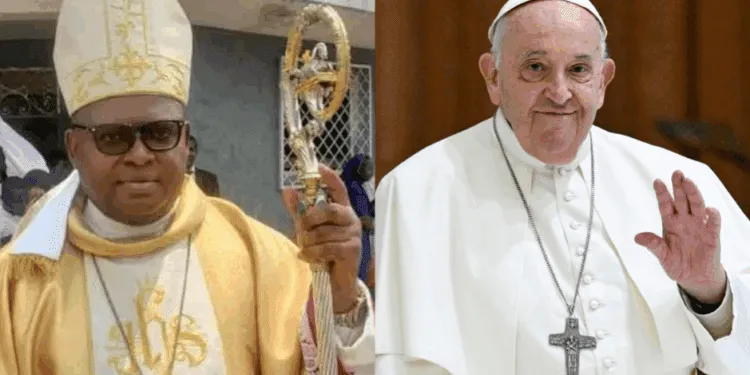The Bishop of Buea, like the rest of the Roman Catholic Church, is mourning the passing of its leader, Pope Francis. The pope died Monday, April 21, at the Vatican after an over two-month battle with illness.
Francis, who was the 266th Pope of the Roman Catholic Church, died at the age of 88.
After the Vatican announced his death, tributes have been pouring in from world leaders. Bishop Michael Bibi of Buea, the Bishop of Cameroon’s oldest diocese, is among the Catholic clergy from all over the world who have paid tributes to the Pope.
He also outlines the anticipated events in the days that follow the Pope’s death.
Bishop Bibi made the explanation during a Monday morning teaching with Christians.
He said several significant actions will be taking place subsequently, including the ringing of bells, lowering of the Vatican flag at all diplomatic missions, and the destruction of the Pope’s ring.
“Christians are encouraged to pray for the repose of his soul,” he said in a message on the diocese’s Facebook page.
What Happens Next?
He continued that the mourning of the Pope will last for nine days according to Catholic tradition. Also, the pontiff must be buried between four and six days after his death.
“His lifeless body will be dressed as the Pope and placed in St Peter’s Basilica in Rome. According to his will, Pope Francis requested a simple funeral. The Dean of the College of Cardinals will preside over the burial Mass,” Bishop Bibi said.
While most popes are buried beneath St. Peter’s Basilica in Rome, Pope Francis chose to be buried at the Basilica of Santa Maria Maggiore, Bibi revealed.
The Pope will be laid to rest with “Rigoto”—a document summarising his work.
After the Pope’s death, the Church enters a state of Sede Vacante, meaning the papal seat is vacant. During this time, the College of Cardinals takes temporary leadership, but they cannot make major decisions until a new Pope is elected.
A conclave with eligible Cardinals (those under 80) takes place two to three weeks after the Pope’s burial to choose the next Pope. The new pope will be announced with white smoke from the chapel. This will be followed by the traditional Habemus Papam as the Pope appears on the balcony of St Peter’s Basilica.
“Pope Francis, the 266th Pope, made history as the first non-European Pope in over 1300 years. His papacy was marked by humility, a focus on social justice, and a deep commitment to the low-income backgrounds and abandoned,” Bishop Michael Bibi wrote.
Who is Pope Francis
He was born on 17 December 1936 as Jorge Mario Bergoglio in Argentina. He comes from Buenos Aires, the Argentinian capital.
At age 21, he suffered a severe bout of pneumonia that led to the removal of part of his right lung.
In 1958, he joined the Jesuits, and in 1969, he was ordained as a Jesuit.
However, before becoming a priest, he worked as a bouncer at a club. Pope Francis equally worked as a janitor at a hosiery company where his father worked.
He became a chemist and technician in a food science laboratory.
He was appointed bishop in 1992 and later became archbishop of Buenos Aires in 1998.
On March 13, 2013, he was elected the 266th pope of the Roman Catholic Church at the age of 76.
He is also the first from the Americas to become pope of the Roman Catholic Church.



